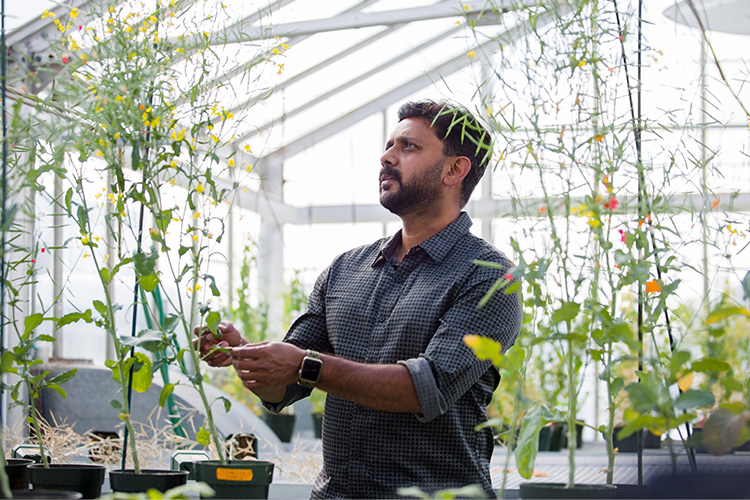UCalgary scientists produce new canola type for potentially higher crop yield

Canola is one of Canada’s most important cash crops, but there’s only so much suitable cropland where the plants can be grown. What if it were possible to modify the height and shape of canola, so more plants could be grown in the same amount of space—potentially increasing crop yield?
In a new study, a team of biologists in the Faculty of Science at the University of Calgary used gene editing to modify canola’s own genes, producing shorter plants with many more branches and flowers.
“We showed that gene editing actually works in canola, and simultaneously improved agronomic traits in canola by changing the plant’s architecture,” says study co-author Dr. Marcus Samuel, PhD, professor and Director of Greenhouse Operations in the Department of Biological Sciences, whose research group did the study.
“We were able to effectively induce such dramatic architectural changes in canola with one single gene,” says study lead author Matija Stanic, who did the research for his master’s degree. He is now doing a PhD, supported by a Max Planck Fellowship, at the University of Potsdam in Germany.
The “green revolution” that began in the 1960s used plant-breeding techniques to produce elite lines of crop plants, including rice and wheat, which were shorter, more compact, and thus able to better utilize nutrients and other inputs. But little work had been done on canola.
“The gene editing technique we used was very precise and had some dramatic results in altering the shoot architecture of the plant,” says study co-author Neil Hickerson, who’s working on his PhD with Samuel. “With this approach, we have much greater potential to increase the yield of each plant.” Dr. Rex Arunraj, PhD, a visiting scientist from the SRM Institute of Technology in Chennai, India, collaborated in the research.
“The gene editing is like a molecular scissors,” Stanic explains. “We engineer the plant to produce the enzymes required to do this little surgery in these genes.” This deactivates the signaling pathway that regulates development of some of the canola plant’s architecture, including height and branching.
The team was then able to crossbreed the edited canola line to eliminate the DNA used for gene editing to obtain the edited strain of canola without any trace of foreign DNA. “Essentially, the plant is modified but the genes that are used to make these edits, or minor surgeries, are gone from the system. So you have a ‘clean’ plant that has been genetically modified to produce a shorter plant with more branches,” Stanic says.
In their modified wild-type canola strain, the team was able to increase the number of branches to about 60 from the typical 20. They also increased the production of flowers by about 200%, within the same reproductive period and lifespan of canola grown in Canada. Typically, 40 to 55% of canola flowers get pollinated and produce seeds, Hickerson says. So, given that same pollination rate in plants with 200% more flowers, “we could potentially see an increase in yield.”
Samuel’s lab is now in discussion with Agriculture and Agri-Food Canada to do some field trials this year to confirm whether the new canola strain produces higher yield. Canola production contributes an estimated $27 billion annually to Canada’s economy and is associated with approximately 250,000 jobs.
This article was adapted and republished with permission from the ![]() University of Calgary.
University of Calgary.
Up next

Nasal spray breakthrough delivers antipsychotic drugs straight to the brain
A team of neuroscientists and engineers at McMaster University has created a nasal spray to deliver antipsychotic medication directly to the brain instead of having it pass through the body.